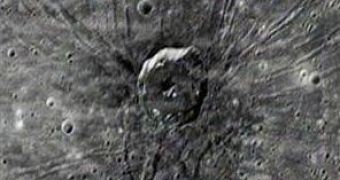After waiting for more that three decades for a spacecraft to return to Mercury and photograph the other half of the planet's surface, NASA finally has access to some of the most spectacular images of the solar system, amongst which a giant crater on the surface that presents more than 50 cracks radiating away from the center. The image was taken two weeks ago during the fly-by of the spacecraft Messenger around Mercury.
The so-called 'Spider' crater represents a unique formation in the solar system, but what led to the creation of such a structure remains mostly a mystery. NASA scientists argue that it could have formed through a volcanic intrusion process under the surface of the planet, which created the troughs originating from the center of the crater.
The Messenger spacecraft is the second probe ever sent to Mercury, after the Mariner 10 mission which spanned from 1974 to 1975, and the first to be put in a stable orbit around the planet. Mariner 10 executed three fly-bys around Mercury during its mission before running out of propellant, which is used to make small trajectory corrections, and is currently orbiting around the Sun. During its three years mission, Mariner 10 was able to map about 45 percent of the surface of the planet, and proved, for the first time, that indeed Mercury has a magnetic field.
On the other hand, Messenger will go into a permanent orbit around the planet on 18 March 2011, but it is scheduled to make two more fly-bys before entering the orbit. The second swing will take place somewhere in October this year, while the final one will be made on September 2009. Since it's launch back in 2004, the Messenger probe has traveled more than 4.9 billion kilometers through the solar system, made three other fly-bys, one around Earth and two around Venus, taken pictures of both planets, made more 1,200 photographs of the surface of Mercury during the approach on 14 January and has recently shown that Mercury is the only planet in the solar system with a magnetosphere extremely similar to that of the Earth.

 14 DAY TRIAL //
14 DAY TRIAL //